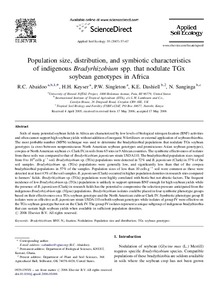| dc.contributor.author | Abaidoo, R.C. |
| dc.contributor.author | Keyser, H. |
| dc.contributor.author | Singleton, P. |
| dc.contributor.author | Dashiell, Kenton E. |
| dc.contributor.author | Sanginga, Nteranya |
| dc.date.accessioned | 2019-12-04T11:18:38Z |
| dc.date.available | 2019-12-04T11:18:38Z |
| dc.date.issued | 2006 |
| dc.identifier.citation | Abaidoo, R., Keyser, H., Singleton, P., Dashiell, K. & Sanginga, N. (2007). Population size, distribution, and symbiotic characteristics of indigenous Bradyrhizobium spp. that nodulate TGx soybean genotypes in Africa. Applied Soil Ecology, 35(1), 57-67. |
| dc.identifier.issn | 0929-1393 |
| dc.identifier.uri | https://hdl.handle.net/20.500.12478/3271 |
| dc.description.abstract | Soils of many potential soybean fields in Africa are characterized by low levels of biological nitrogen fixation (BNF) activities and often cannot support high soybean yields without addition of inorganic N fertilizers or external application of soybean rhizobia. The most probable number (MPN) technique was used to determine the bradyrhizobial populations that nodulate TGx soybean genotypes (a cross between nonpromiscuous North American soybean genotypes and promiscuous Asian soybean genotypes), cowpea or North American soybean cv. Clark IV, in soils from 65 sites in 9 African countries. The symbiotic effectiveness of isolates from these soils was compared to that of Bradyrhizobium japonicum strain USDA110. The bradyrhizobial population sizes ranged from 0 to 104 cells g−1 soil. Bradyrhizobium sp. (TGx) populations were detected in 72% and B. japonicum (Clark) in 37% of the soil samples. Bradyrhizobium sp. (TGx) populations were generally low, and significantly less than that of the cowpea bradyrhizobial populations in 57% of the samples. Population sizes of less than 10 cells g−1 soil were common as these were detected in at least 43% of the soil samples. B. japonicum (Clark) occurred in higher population densities in research sites compared to farmers’ fields. Bradyrhizobium sp. (TGx) populations were highly correlated with biotic but not abiotic factors. The frequent incidence of low Bradyrhizobium sp. (TGx) populations is unlikely to support optimum BNF enough for high soybean yields while the presence of B. japonicum (Clark) in research fields has the potential to compromise the selection pressure anticipated from the indigenous Bradyrhizobium spp. (Vigna) populations. Bradyrhizobium isolates could be placed in four symbiotic phenotype groups based on their effectiveness on a TGx soybean genotype and the North American cultivar Clark IV. Symbiotic phenotype group II isolates were as effective as B. japonicum strain USDA110 on both soybean genotypes while isolates of group IV were effective on the TGx soybean genotype but not on the Clark IV. The group IV isolates represent a unique subgroup of indigenous bradyrhizobia that can sustain high soybean yields when available in sufficient population densities. |
| dc.language.iso | en |
| dc.subject | Bradyrhizobium |
| dc.subject | Bnf |
| dc.subject | N2 Fixation |
| dc.subject | Nodulation |
| dc.subject | Population Size And Distribution |
| dc.subject | Tgx Soybean Genotypes |
| dc.title | Population size, distribution, and symbiotic characteristics of indigenous Bradyrhizobium spp. that nodulate TGx soybean genotypes in Africa |
| dc.type | Journal Article |
| dc.description.version | Peer Review |
| cg.contributor.affiliation | University of Hawaii |
| cg.contributor.affiliation | International Institute of Tropical Agriculture |
| cg.contributor.affiliation | International Center for Tropical Agriculture |
| cg.coverage.region | Africa |
| cg.coverage.region | West Africa |
| cg.coverage.region | Southern Africa |
| cg.coverage.region | Central Africa |
| cg.coverage.region | East Africa |
| cg.coverage.country | Benin |
| cg.coverage.country | Cameroon |
| cg.coverage.country | Ghana |
| cg.coverage.country | Kenya |
| cg.coverage.country | Nigeria |
| cg.coverage.country | Tanzania |
| cg.coverage.country | Togo |
| cg.coverage.country | Uganda |
| cg.coverage.country | Zimbabwe |
| cg.isijournal | ISI Journal |
| cg.authorship.types | CGIAR and advanced research institute |
| cg.iitasubject | Genetic Improvement |
| cg.iitasubject | Soybean |
| cg.iitasubject | Plant Production |
| cg.iitasubject | Cowpea |
| cg.iitasubject | Grain Legumes |
| cg.accessibilitystatus | Limited Access |
| local.dspaceid | 94945 |
| cg.identifier.doi | http://dx.doi.org/10.1016/j.apsoil.2006.05.006 |

